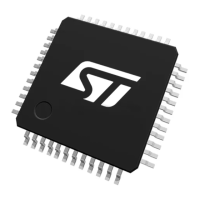Reset and clock control (RCC) RM0444
168/1390 RM0444 Rev 5
External crystal/ceramic resonator (HSE crystal)
The 4 to 48 MHz external oscillator has the advantage of producing a very accurate rate on
the main clock.
The associated hardware configuration is shown in Figure 11. Refer to the electrical
characteristics section of the datasheet for more details.
The HSERDY flag in the Clock control register (RCC_CR) indicates if the HSE oscillator is
stable or not. At startup, the clock is not released until this bit is set by hardware. An
interrupt can be generated if enabled in the Clock interrupt enable register (RCC_CIER).
The HSE Crystal can be switched on and off using the HSEON bit in the Clock control
register (RCC_CR).
External source (HSE bypass)
In this mode, an external clock source must be provided. It can have a frequency of up to
48 MHz. This mode is selected by setting the HSEBYP and HSEON
bits in the Clock control
register (RCC_CR). The external clock signal (square, sinus or triangle) with ~40-60 % duty
cycle depending on the frequency (refer to the datasheet) must drive the OSC_IN pin, on
devices where OSC_IN and OSC_OUT pins are available (see Figure 11). The OSC_OUT
pin can be used as a GPIO.
The OSC_OUT pin can be used as a GPIO or it can be configured as OSC_EN alternate
function, to provide an enable signal to external clock synthesizer. It allows stopping the
external clock source when the device enters low power modes.
Note: For details on pin availability, refer to the pinout section in the corresponding device
datasheet.
To minimize the consumption, it is recommended to use the square signal.
5.2.2 HSI16 clock
The HSI16 clock signal is generated from an internal 16 MHz RC oscillator.
The HSI16 RC oscillator has the advantage of providing a clock source at low cost (no
external components). It also has a faster startup time than the HSE crystal oscillator.
However, even after calibration, it is less accurate than an oscillator using a frequency
reference such as quartz crystal or ceramic resonator.
The HSISYS clock derived from HSI16 can be selected as system clock after wakeup from
Stop modes (Stop 0 or Stop 1). Refer to Section 5.3: Low-power modes. It can also be used
as a backup clock source (auxiliary clock) if the HSE crystal oscillator fails. Refer to
Section 5.2.9: Clock security system (CSS).
Calibration
RC oscillator frequencies can vary from one chip to another due to manufacturing process
variations. To compensate for this variation, each device is factory calibrated to 1 %
accuracy at T
A
=25°C.
After reset, the factory calibration value is loaded in the HSICAL[7:0] bits in the Internal
clock source calibration register (RCC_ICSCR).
Voltage or temperature variations in the application may affect the HSI16 frequency of the
RC oscillator. It can be trimmed using the HSITRIM[6:0] bits in the Internal clock source
calibration register (RCC_ICSCR).

